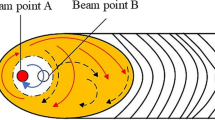Abstract
Hot wire laser welding reduces the requirement of wire feeding accuracy and improves wire deposition efficiency with preheating wire by resistance heat. Due to merits like low heat input and high deposition rate, this method has broad potential applications like welding and additive manufacturing. It is a key problem to maintain stable wire transfer in hot wire laser welding since the preheated wire should be kept contacted with the work piece to maintain high temperature. A high-speed imaging system was used to observe wire transfer behaviors, which are divided into three types: fusing transfer, continuous transfer, and wire hit transfer. Only the continuous transfer is the stable wire transfer, which guarantees good weld formation. The wire transfer behavior is determined by wire temperature, and the temperature criterion of wire transfer is obtained by image analysis and temperature measurement. Two characteristic points P1 and P2 on the filler wire were found out, whose temperatures were used to judge wire transfer behaviors. The temperature criterion of the stable wire transfer is interpreted that the temperature of P1 (T P1) must be no more than the wire solidus and the temperature of P2 (T P2) must be no less than the wire liquidus. A heat conduction model of hot wire laser welding was established to calculate T P1 and T P2 for the used 308-L stainless wire. The welding parameters, which made up isothermal surfaces of T P1 = 1398 °C and T P2 = 1454 °C, respectively, the solidus and liquidus of the used wire, were obtained by iteration calculation of wire temperature. The parameters window of the stable wire transfer was located between the two isothermal surfaces. For the stable wire transfer in hot wire laser welding, the resistance heat of the wire cannot exceed the heat which fuses the wire tip outside the molten pool. Meanwhile, the total heat of the wire, including the resistance heat and the heat conducted from the molten pool, must exceed the heat which melts the wire tip inside the molten pool.
Similar content being viewed by others
References
Salminen AS, Kujanpaa VP, Moisio TJ (1996) Interactions between laser beam and filler metal. Weld J 75(1):9–13
Sun Z, Salminen AS (1997) Current status of laser welding with wire feed. Mat Manuf Process 12(5):759–777
Richard P, Martukanitz A (2005) Critical review of laser welding. In Proceedings of SPIE. Bellingham, SPIE, 5706: 11–24,
Nurminen J, Riihimäki J, Näkki J, Vuoristo P (2006) Comparison of laser cladding with powder and hot and cold wire techniques. In Proceedings of ICALEO. Scottsdale, Laser Institute of America: 634–637
Nurminen J, Riihimäki J, Näkki J, Vuoristo P (2007) Hot-wire cladding process studies. In Proceedings of ICALEO. Orlando, Laser Institute of America: 947–952
Liu S, Liu W, Harooni M, Ma J, Kovacevic R (2014) Real-time monitoring of the laser hot-wire cladding of Inconel 625. Opt Laser Technol 62:124–134
Wen P, Feng ZH, Zheng SQ (2015) Formation quality optimization of laser hot wire cladding for repairing martensite precipitation hardening stainless steel. Opt Laser Technol 65:180–188
Ohnishi T, Kawahito Y, Mizutani M, Katayama S (2013) Butt welding of thick high strength steel plate with a high power laser and hot wire to improve tolerance to gap variance and control weld metal oxygen content. Sci Technol Weld Join 18(4):314–322
Phaoniam R, Shinozaki K, Yamamoto M, Kadoi K, Tsuchiya S, Nishijima A (2013) Development of a highly efficient hot-wire laser hybrid process for narrow-gap welding: welding phenomena and their adequate conditions. Weld World 57:607–613
Jones M, Erikson C, Nowak D (2004) Laser hot wire welding for minimizing defects. In Proceedings of ICALEO. Orlando, Laser Institute of America: 1–8
Yamamoto M, Shinozaki K, Kadoi K, Inoue T, Fukahori M, Kitahara Y (2011) Development of hot-wire laser welding method for lap joint of steel sheet with wide gap. Q J Jpn Weld Soc 29(3):58–61
Kadoi K, Shinozaki K, Yamamoto M, Owaki K, Inose K, Tkayanagi D (2011) Development of high efficiency high quality hot-wire laser fillet welding process. Q J Jpn Weld Soc 29(3):62–65
Liu W, Ma J, Liu S, Kovacevic R (2015) Experimental and numerical investigation of laser hot wire welding. Int J Adv Manuf Technol 78(9-12):1485–1499
Liu W, Liu S, Ma J, Kovacevic R (2014) Real-time monitoring of the laser hot-wire welding process. Opt Laser Technol 57:66–76
Author information
Authors and Affiliations
Corresponding author
Rights and permissions
About this article
Cite this article
Peng, W., Jiguo, S., Shiqing, Z. et al. Control of wire transfer behaviors in hot wire laser welding. Int J Adv Manuf Technol 83, 2091–2100 (2016). https://doi.org/10.1007/s00170-015-7696-8
Received:
Accepted:
Published:
Issue Date:
DOI: https://doi.org/10.1007/s00170-015-7696-8




